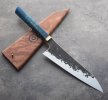Stacy E. Apelt - Bladesmith
ilmarinen - MODERATOR
Moderator
Knifemaker / Craftsman / Service Provider
- Joined
- Aug 20, 2004
- Messages
- 38,265
On a Japanese knife and most kitchen blades, I wuld say it is pretty much a rule.
Besides aesthetics, the reason the handle should be parallel is both ergonomics and function. It allows a better control of the edge and eliminates excess force on the wrist in a cut.
Just to make it clear, the handle does not need to be the same size as the spine (as in a full tang), but is needs to be parallel. In the best scenario, the top of the handle should be fairly close to the line of the spine.
This image may help ( and provide some nomenclature):

Besides aesthetics, the reason the handle should be parallel is both ergonomics and function. It allows a better control of the edge and eliminates excess force on the wrist in a cut.
Just to make it clear, the handle does not need to be the same size as the spine (as in a full tang), but is needs to be parallel. In the best scenario, the top of the handle should be fairly close to the line of the spine.
This image may help ( and provide some nomenclature):

Last edited:

